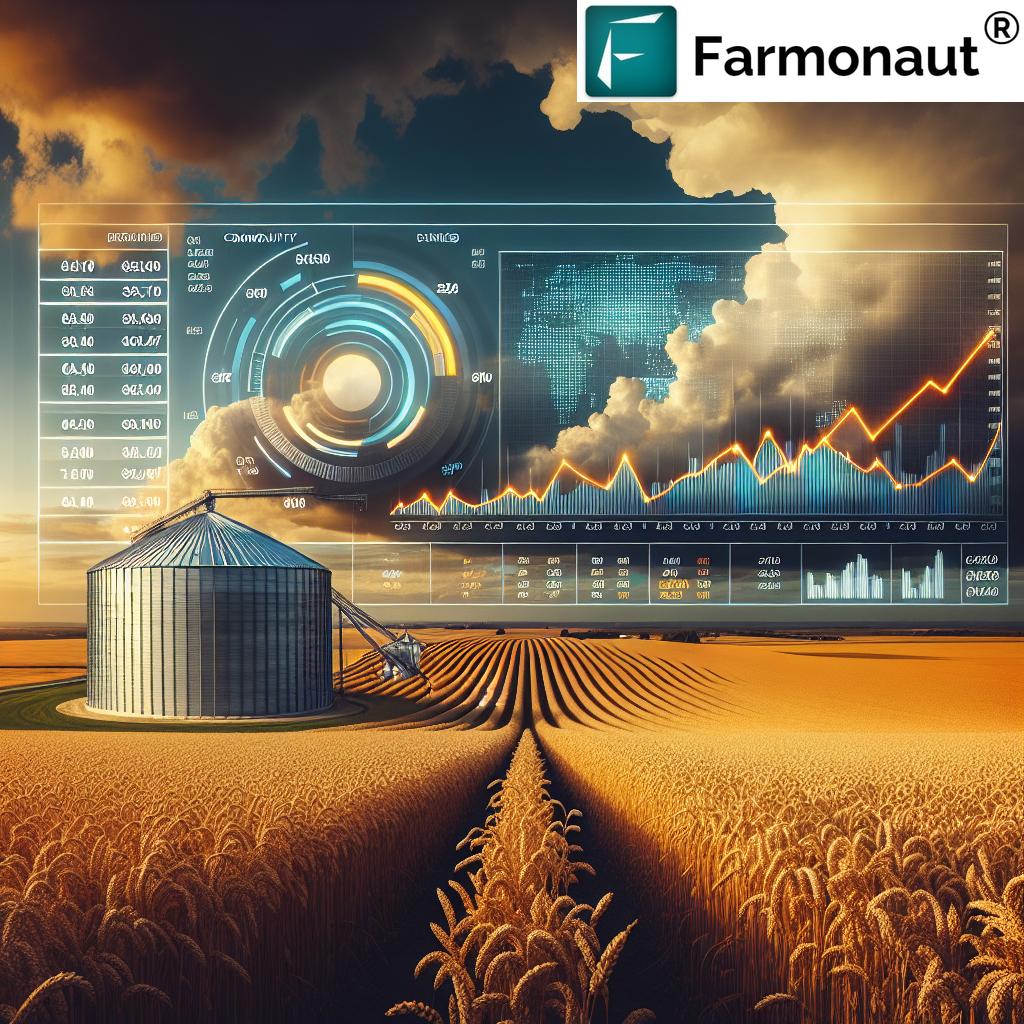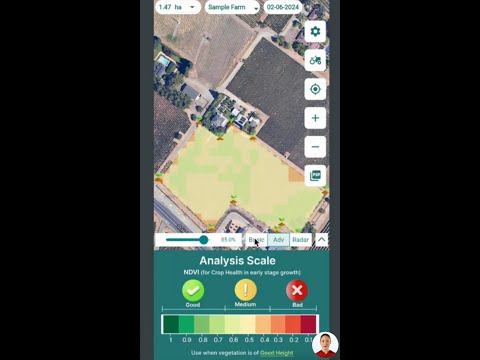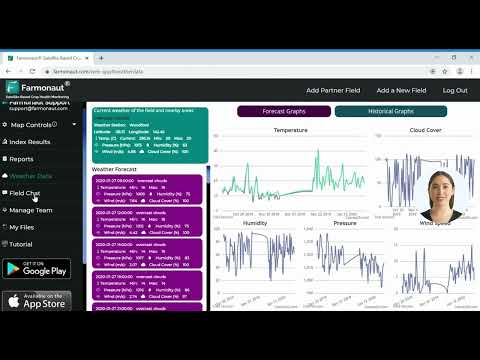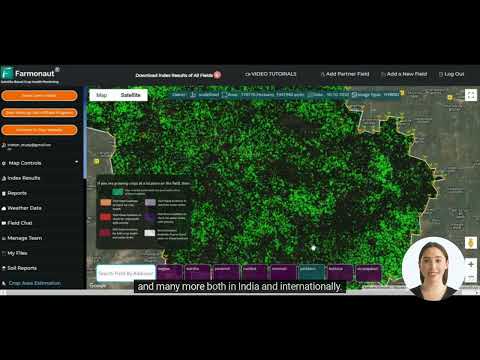Global Grain Market Outlook: Soybean Futures Dip Amid Trade Tensions and South American Supply Surge
“Argentina’s lowered soybean and corn estimates have contributed to a 5-7% dip in global soybean futures prices.”
In the ever-evolving landscape of global agriculture, we find ourselves at a critical juncture where soybean futures prices and the corn market outlook are facing significant challenges. As we delve into the intricacies of the agricultural commodities market, it’s crucial to understand the complex interplay of factors shaping the future of key crops like soybeans, corn, and wheat. From trade tensions to abundant South American crop yields, the dynamics influencing these markets are both diverse and interconnected.
At Farmonaut, we recognize the importance of staying informed about these market trends, as they directly impact farmers’ decision-making processes and the overall agricultural landscape. Our satellite-based farm management solutions provide valuable insights that can help farmers navigate these turbulent times more effectively.

The Current State of Soybean Futures
The Chicago Board of Trade (CBOT) commodities have been showing a downward trend for soybeans, with the most active contract sliding 0.2% to $10.08-1/2 a bushel. This dip in soybean futures prices is not an isolated incident but part of a broader pattern that has been unfolding in recent weeks. The primary drivers behind this trend include:
- Trade conflicts disrupting global grain trade
- Abundant South American crop yields pressuring prices
- Concerns over potential disruptions from US tariffs on agriculture
These factors have collectively contributed to a bearish outlook for the soybean market, with supply currently outpacing demand. As one Singapore-based grains trader aptly put it, “The supply side for soybeans is pretty bearish. We have big crops in South America, and the trade war is going to hit demand for U.S. agriculture if tariffs remain in place.”
Corn Market Outlook: Facing Similar Challenges
The corn market outlook is closely mirroring the trends seen in soybeans. CBOT corn futures have given up nearly 1% to $4.60-3/4 a bushel. This decline can be attributed to similar factors affecting the soybean market, including:
- Abundant global supplies, particularly from South America
- Trade tensions impacting export demand
- Uncertainty surrounding US agricultural policies
The interplay between corn and soybean markets is significant, as these crops often compete for acreage and are subject to similar market forces. Farmers and investors alike are closely monitoring these developments, as they have far-reaching implications for crop planning and investment strategies.
Wheat: A Different Story Unfolding
While soybeans and corn face downward pressure, wheat has been gaining ground. The wheat export forecast, particularly from Russia, has been reduced, influencing supply and demand dynamics. IKAR consultancy has cut its baseline 2024/25 wheat export forecast for Russia to around 41 million tons from 42.5 million tons.
This reduction in the wheat export forecast has led to a slight increase in wheat prices, with CBOT wheat shedding 0.3% to $5.60-3/4 a bushel. However, despite this minor setback, wheat is set for a weekly gain of 1.8%, outperforming both soybeans and corn.
The divergence in wheat’s performance highlights the importance of considering each grain commodity independently while also understanding their interconnectedness in the global agricultural market.
South American Crop Yields: A Game Changer
The abundance of South American crop yields, particularly in soybeans and corn, has been a significant factor in the current market dynamics. Argentina, a key player in global grain production, has recently adjusted its crop estimates:
- 2024/25 soybean crop estimate lowered to 46.5 million metric tons (down from 47.5 million tons)
- 2024/25 corn harvest outlook reduced to 44.5 million tons (from 46 million tons)
These adjustments, while indicating a slight decrease in production, still represent substantial yields that are putting pressure on global prices. The abundant supply from South America is offsetting potential shortfalls in other regions and contributing to the overall bearish sentiment in the soybean and corn markets.

Trade Tensions and Their Impact on Global Grain Trade
The specter of trade conflicts looms large over the agricultural commodities market. Recent developments in US trade policies have sent ripples through the global grain trade:
- Implementation of revised US tariffs on all steel and aluminum imports
- Retaliatory measures announced by the European Union and Canada
- Potential 25% duty on US corn by the EU
- Possible tariffs on US soybeans
These trade tensions are creating uncertainty in the market and raising concerns about potential disruptions to US agricultural exports. The impact of US tariffs on agriculture extends beyond immediate price fluctuations, potentially reshaping long-established trade relationships and supply chains.
“Russia’s reduced wheat export forecast has led to a 3% increase in wheat prices on the Chicago Board of Trade.”
Soybean Supply and Demand: A Delicate Balance
The current soybean supply and demand situation is characterized by a delicate balance that’s tipping towards oversupply. Several factors are contributing to this scenario:
- Record-breaking harvests in South America
- Potential decrease in demand due to trade conflicts
- Shifting consumption patterns in major importing countries
As we navigate this complex landscape, tools like Farmonaut’s satellite-based crop monitoring can provide valuable insights into crop health and yield potential, helping farmers make informed decisions in response to market conditions.
Comparative Analysis of Major Grain Commodities
| Commodity | Current Futures Price (est.) | Price Change (% from prev. month) | Major Producing Countries | Production Forecast (MMT) | Export Forecast (MMT) | Key Market Drivers |
|---|---|---|---|---|---|---|
| Soybeans | $10.08/bushel | -2% | USA, Brazil, Argentina | 380 | 160 | Trade tensions, South American yields |
| Corn | $4.60/bushel | -1.5% | USA, China, Brazil | 1200 | 180 | Abundant supply, ethanol demand |
| Wheat | $5.60/bushel | +1.8% | China, India, Russia | 780 | 190 | Reduced Russian exports, weather concerns |
This comparative analysis highlights the nuanced differences between the major grain commodities. While soybeans and corn are facing downward pressure, wheat is showing resilience and even slight gains. These trends underscore the importance of diversification in agricultural portfolios and the need for adaptive strategies in farm management.
The Role of Technology in Navigating Market Challenges
In these challenging times, technology plays a crucial role in helping farmers and agribusinesses navigate market uncertainties. Farmonaut’s suite of tools, including satellite-based crop health monitoring and AI-driven advisory systems, can provide valuable insights to optimize crop management and respond to market trends.
- Real-time crop health monitoring allows for timely interventions
- AI-based advisory systems provide personalized recommendations
- Blockchain-based traceability enhances supply chain transparency
- Resource management tools optimize input usage and reduce costs
By leveraging these technologies, farmers can make data-driven decisions that help mitigate risks associated with market volatility and maximize their returns in the face of challenging global conditions.
Explore Farmonaut’s API for advanced agricultural insights
Implications for Global Food Security and Economic Stability
The current trends in the global grain market have far-reaching implications for food security and economic stability worldwide. As major staple crops face price pressures and supply chain disruptions, there are concerns about:
- Potential food price inflation in import-dependent countries
- Economic challenges for farmers and rural communities in exporting nations
- Shifts in global trade patterns and economic relationships
- Long-term impacts on agricultural investment and innovation
These concerns underscore the need for resilient and adaptive agricultural systems that can withstand market shocks and ensure stable food supplies. Technologies like those offered by Farmonaut can play a crucial role in building such resilience by providing farmers with the tools to optimize their operations and respond effectively to changing market conditions.
The Path Forward: Strategies for Farmers and Investors
As we navigate these turbulent times in the global grain market, several strategies can help farmers and investors mitigate risks and capitalize on opportunities:
- Diversification: Spreading risk across different crops and markets
- Technology Adoption: Leveraging tools like Farmonaut for data-driven decision-making
- Market Education: Staying informed about global trends and policy changes
- Sustainable Practices: Implementing methods that reduce input costs and improve resilience
- Value-Added Products: Exploring opportunities in processed or specialty grain markets
By adopting these strategies and staying agile in response to market changes, stakeholders in the agricultural sector can better position themselves for long-term success.
Access Farmonaut’s API Developer Docs for integration guidance
Conclusion: Navigating Uncertainty with Technology and Insight
The global grain market is currently navigating a complex landscape of challenges and opportunities. From the dip in soybean futures prices to the nuanced outlook for corn and wheat, market participants must remain vigilant and adaptive. The interplay of trade tensions, abundant South American crop yields, and shifting global demand patterns creates a dynamic environment that requires sophisticated analysis and responsive strategies.
In this context, the role of technology in agriculture becomes increasingly crucial. Farmonaut’s suite of satellite-based farm management solutions offers a powerful toolset for farmers and agribusinesses looking to optimize their operations in the face of market uncertainty. By providing real-time insights into crop health, weather patterns, and market trends, these technologies empower stakeholders to make informed decisions that can enhance productivity, reduce risks, and improve overall resilience.
As we look to the future, the integration of advanced technologies like AI, blockchain, and satellite monitoring will continue to reshape the agricultural landscape. By embracing these innovations and staying attuned to global market dynamics, farmers and investors can navigate the challenges ahead and contribute to a more stable and sustainable global food system.
FAQ Section
- Q: How are trade tensions affecting soybean futures prices?
A: Trade tensions, particularly between major producers and consumers, are creating uncertainty in the market. This uncertainty can lead to reduced demand for US soybeans, putting downward pressure on futures prices. - Q: What role does South American crop yield play in the global grain market?
A: South American countries, especially Brazil and Argentina, are major producers of soybeans and corn. Their abundant yields are contributing to global oversupply, which is a key factor in the current downward pressure on prices. - Q: Why is wheat performing differently from soybeans and corn?
A: Wheat is experiencing different market dynamics due to reduced export forecasts from major producers like Russia. This tightening of supply is leading to slight price increases, in contrast to the oversupply situation for soybeans and corn. - Q: How can farmers use technology to navigate market challenges?
A: Farmers can leverage technologies like Farmonaut’s satellite-based crop monitoring and AI advisory systems to make data-driven decisions. These tools provide insights into crop health, weather patterns, and market trends, helping farmers optimize their operations and respond to market changes effectively. - Q: What are the long-term implications of current grain market trends?
A: Current trends could lead to shifts in global trade patterns, impact food security in import-dependent countries, and influence agricultural investment and innovation. They may also accelerate the adoption of technology in farming practices to improve resilience and efficiency.
Earn With Farmonaut: Affiliate Program
Earn 20% recurring commission with Farmonaut’s affiliate program by sharing your promo code and helping farmers save 10%. Onboard 10 Elite farmers monthly to earn a minimum of $148,000 annually—start now and grow your income!
Farmonaut Subscriptions
As we continue to navigate the complexities of the global grain market, staying informed and leveraging advanced technologies will be key to success. Farmonaut remains committed to providing cutting-edge solutions that empower farmers and agribusinesses to thrive in this dynamic environment.







